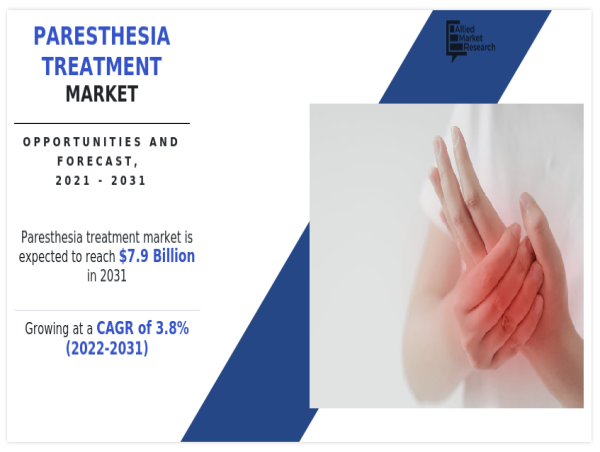The growth of paresthesia treatment market share is driven by rise in prevalence of disease such as cancer, surge in geriatric population, and lack of proper nutrients in the food. In addition, increase in prevalence of paresthesia among the population, poor lifestyle, and increase in healthcare expenditure would further supplement the paresthesia treatment market growth.
Executive Snapshot — Key Take‑aways
Market Expansion: Demand rises steadily on the back of an ageing global population, increased cancer prevalence, and growing awareness of neuropathic disorders.
Disease Burden Shift: Chronic paresthesia now dominates > 60 % of diagnosed cases, spurring long‑term pharmacological management needs.
Topical Formulations in Focus: Non‑systemic creams and gels contributed ~32 % of 2021 revenue thanks to easy OTC access and favourable safety profiles.
Retail Pharmacies Rule: Brick‑and‑mortar outlets accounted for ~45 % of global drug sales, reflecting convenience and patient trust.
North America Leads (2021 share ≈ 40 %): Strong payer coverage, specialist centres, and robust R&D pipelines underpin leadership.
White‑Space Opportunity: Asia‑Pacific is forecast to post the fastest regional CAGR (> 5 %) on the strength of rising disposable incomes and underdiagnosed patient pools.
Get a Sample Copy of this Report: https://www.alliedmarketresearch.com/request-sample/A17080
Market Drivers
Rising Neuropathic Complications of Cancer & Chemotherapy – Peripheral neuropathies are common side‑effects, enlarging the addressable market.
Geriatric Demographics – People aged ≥ 65 are at higher risk of nerve‑related sensations; the UN projects this cohort to double by 2050.
Dietary & Lifestyle Gaps – Urban diets low in B‑vitamins and chronic alcohol use elevate paresthesia incidence.
Healthcare Spend Uptrend – Expanding insurance coverage across emerging economies improves access to diagnostics and therapy.
Restraints & Challenges
Limited Drug Effectiveness – Conventional analgesics offer only symptomatic relief; sub‑optimal efficacy curbs long‑term adherence.
Stringent Regulatory Pathways – CNS‑acting agents face rigorous safety scrutiny, prolonging approval timelines and R&D costs.
Awareness Deficit in Low‑Income Regions – Underreporting of neuropathic symptoms delays intervention and skews epidemiological data.
Emerging Opportunities
Targeted Novel Mechanisms – R&D funds are flowing into ion‑channel modulators and micro‑RNA therapeutics aimed at nerve repair.
Digital Therapeutics & Remote Monitoring – Wearable neuro‑stimulation patches and mobile apps for symptom tracking promise adjunct revenue streams.
Strategic Partnerships – Pharma–biotech collaborations and academic consortia accelerate pipeline progression and market entry in niche sub‑segments.
Regional Outlook
North America
Comprehensive insurance reimbursement and 20+ active clinical trials ensure sustained dominance.
Europe
Strong regulatory harmonisation (EMA) and ageing population support mid‑single‑digit growth.
Asia‑Pacific
Highest unmet need; Chinese‑ and Indian‑led investments in generics and biosimilars expand access.
LAMEA
Gradual uptake; public‑private partnerships in Brazil and Saudi Arabia target diagnostic gaps.
Competitive Landscape (Illustrative)
Pfizer Inc. – Market leader in gabapentinoid class; exploring transdermal delivery platforms.
Teva Pharmaceutical – Robust generic pipeline; cost‑competitive topical lidocaine.
Grünenthal GmbH – Pioneering high‑concentration capsaicin patches for post‑herpetic neuralgia.
AbbVie – R&D on α‑calcitonin gene‑related peptide inhibitors for neuropathic symptom modulation.
Strategic Recommendations
Differentiate via Novel Delivery Routes: Invest in micro‑needle patches and sustained‑release implants to enhance patient compliance.
Leverage AI‑Driven Diagnostics: Integrate EMG data analytics and symptom‑tracking apps for earlier intervention and personalised dosing.
Expand Patient‑Support Ecosystems: Co‑pay assistance, tele‑counselling, and lifestyle coaching boost brand loyalty and real‑world outcomes.
Seek Fast‑Track Designations: For first‑in‑class agents targeting severe chronic paresthesia, accelerated FDA/EMA pathways can shave 6‑12 months off launch timelines.
Bottom Line
Although paresthesia remains largely a symptom rather than a standalone disease, its rising prevalence—particularly chronic forms linked to metabolic and neurologic disorders—creates a USD 2.5 billion incremental opportunity by 2031. Companies that blend innovative formulations, digital adjuncts, and strategic market access stand to capture outsized value in this moderate‑growth but under‑served therapeutic space.
Enquire Before Buying: https://www.alliedmarketresearch.com/purchase-enquiry/A17080
David Correa
Allied Market Research
+ 1800-792-5285
email us here
Visit us on social media:
LinkedIn
Facebook
YouTube
X
Legal Disclaimer:
EIN Presswire provides this news content "as is" without warranty of any kind. We do not accept any responsibility or liability for the accuracy, content, images, videos, licenses, completeness, legality, or reliability of the information contained in this article. If you have any complaints or copyright issues related to this article, kindly contact the author above.
![]()



